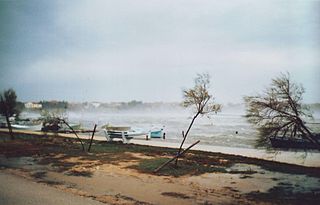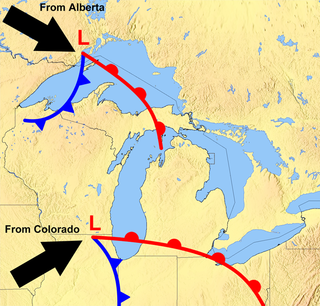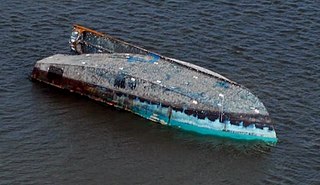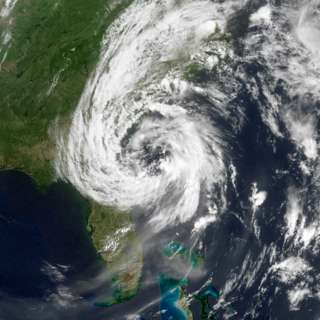In sailing, lying ahull is a controversial method of weathering a storm, executed by downing all sails, battening the hatches and locking the tiller to leeward so the boat tries to point to windward but this is balanced by the force of wind and waves. A sea anchor is not used, allowing the boat to drift freely, completely at the mercy of the storm. Ideally the boat should rest with the wind just forward of the beam so the boat is not broadside onto the waves. Modern boats with fin keels may have too much windage at the bows for this technique and come to rest broadside on or may not be stable at all.

Cruising by boat is an activity that involves living for extended time on a vessel while traveling from place to place for pleasure. Cruising generally refers to trips of a few days or more, and can extend to round-the-world voyages.

Sailing employs the wind—acting on sails, wingsails or kites—to propel a craft on the surface of the water, on ice (iceboat) or on land over a chosen course, which is often part of a larger plan of navigation.

The bora is a northerly to north-easterly katabatic wind in areas near the Adriatic Sea. Similar nomenclature is used for north-eastern winds in other littoral areas of eastern Mediterranean and Black Sea basins.

The Chicago Yacht Club Race to Mackinac is a 333-mile annual yacht race starting in Lake Michigan off Chicago, Illinois, and ending in Lake Huron off Mackinac Island, Michigan. It is hosted and managed by the Chicago Yacht Club. The "Mac" was first run in 1898 and is the oldest annual freshwater distance race in the world. The race hosts several hundred competitors each year and over 3,000 sailors.

A sea anchor is a device that is streamed from a boat in heavy weather. Its purpose is to stabilize the vessel and to limit progress through the water. Rather than tethering the boat to the seabed with a conventional anchor, a sea anchor provides hydrodynamic drag, thereby acting as a brake. Normally attached to a vessel's bows, a sea anchor can prevent the vessel from turning broadside to the waves and being overwhelmed by them.
This is a glossary of nautical terms; an alphabetical listing of terms and expressions connected with ships, shipping, seamanship and navigation on water, but not necessarily on the sea. Some remain current, while many date from the 17th to 19th centuries. The word nautical derives from the Latin nauticus, from Greek nautikos, from nautēs: sailor, from naus: ship.

Capsizing or keeling over occurs when a boat or ship is rolled on its side or further by wave action, instability or wind force beyond the angle of positive static stability or it is upside down in the water. The act of recovering a vessel from a capsize is called righting. Capsize may result from broaching, knockdown, loss of stability due to cargo shifting or flooding, or in high speed boats, from turning too fast.

A drogue is a device trailed behind a boat on a long line attached to the stern. A drogue is used to slow the boat down in a storm and to prevent the hull from becoming side-on to the waves. A boat that has deployed a drogue should not overspeed down the slope of a wave and crash into the next one, nor will the vessel broach. By slowing the vessel, the drogue makes the vessel easier to control in heavy weather and will help to prevent pitchpoling.

The Great Lakes Storm of 1913 was a blizzard with hurricane-force winds that devastated the Great Lakes Basin in the Midwestern United States and Southwestern Ontario, Canada, from November 7 to 10, 1913. The storm was most powerful on November 9, battering and overturning ships on four of the five Great Lakes, particularly Lake Huron.

Porte des Morts, also known as Porte des Mortes, the Door of Death, and Death's Door is a strait linking Lake Michigan and Green Bay between the northern tip of the Door Peninsula and the southernmost of the Potawatomi Islands. At its narrowest reach between Plum Island and the peninsula, the Porte des Morts Passage is about one and one third miles across. The name is French and means, literally, "the door of the dead".

The Battle of Trafalgar was fought between British and Franco-Spanish fleets on 21 October 1805. A force of 27 British ships of the line faced 33 allied ships. Both forces were formed in two columns; the British sailed parallel, the allied one following the other.

Cape Horn is the southernmost headland of the Tierra del Fuego archipelago of southern Chile, and is located on the small Hornos Island. Although not the most southerly point of South America, Cape Horn marks the northern boundary of the Drake Passage and marks where the Atlantic and Pacific Oceans meet.

In dinghy sailing, a boat is said to be turtling or to turn turtle when the boat is fully inverted with the mast pointing down to the lake bottom, riverbed, or seabed. The name stems from the appearance of the upside-down boat, similar to the carapace of a sea turtle. The term can be applied to any vessel; turning turtle is less frequent but more dangerous on ships than on smaller boats. It is rarer but more hazardous for multihulls than for monohulls, because of multihulls are harder to flip in both directions. Measures can be taken to prevent a capsize from becoming a turtle.

In sailing, heaving to is a way of slowing a sailing vessel's forward progress, as well as fixing the helm and sail positions so that the vessel does not have to be steered. It is commonly used for a "break"; this may be to wait for the tide before proceeding, or to wait out a strong or contrary wind. For a solo or shorthanded sailor it can provide time to go below deck, to attend to issues elsewhere on the boat or to take a meal break. It is also used as a storm tactic.
A lee shore, sometimes also called aleeward, is a nautical term to describe a stretch of shoreline that is to the lee side of a vessel—meaning the wind is blowing towards land. Its opposite, the shore on the windward side of the vessel, is called the weather or windward shore.

Subtropical Storm Andrea was the first named storm to form in May in the Atlantic Ocean in 26 years. Andrea caused large waves and tropical-storm force winds along the southeast coast of the United States. The first named storm and the first subtropical cyclone of the 2007 Atlantic hurricane season, Andrea developed out of a non-tropical low on May 9 about 150 miles (240 km) northeast of Daytona Beach, Florida, three weeks before the official start of the season. After encountering dry air and strong vertical wind shear, Andrea weakened to a subtropical depression on May 10 while remaining nearly stationary, and the National Hurricane Center discontinued advisories early on May 11. Andrea's remnant was subsequently absorbed into another extratropical storm on May 14. Andrea was the first pre-season storm to develop since Tropical Storm Ana in April 2003. Additionally, the storm was the first Atlantic named storm in May since Tropical Storm Arlene in 1981.
A sailing boat that is carrying too much sail for the current wind conditions is said to be over-canvassed. An over-canvassed boat, whether a dinghy, a yacht or a sailing ship, is difficult to steer and control and tends to heel or roll too much. If the wind continues to rise, an over-canvassed sailing boat will become dangerous and ultimately gear may break or it may round-up into the wind, broach or capsize. Any of these eventualities puts the safety of the crew and the vessel in danger. To over-canvass a sailing boat is considered unseamanlike and imprudent. In order to reduce sail, individual sails may be lowered or furled and existing sails may be reefed. Counter-intuitively, many boats will sail faster, and certainly more smoothly, comfortably and safely, when carrying the correct amount of sail in a strong wind than they would if over-canvassed and excessively rolling, heeling, carrying too much weather helm or repeatedly rounding up.
DS Seacrest, also known as "the Scan Queen", was a drill ship built by Far East Levingston Shipbuilding Ltd., Singapore, owned by Unocal Corporation and operated by Great Eastern Drilling and Engineering company. It was sunk by Typhoon Gay in the Gulf of Thailand on 3 November 1989. Ninety-one rig workers were killed after the vessel capsized, resulting in a massive legal case brought against the ship's owners UNOCAL. There were only six reported survivors: one Indonesian diver and five Thai rig crew, although these figures vary slightly depending on the source, though all of them agree the death toll would make the sinking the 3rd deadliest offshore disaster in history. Many of the bodies were never recovered. Typhoon Gay produced winds of 100 knots (51 m/s) or more with 12-metre (40 ft) waves. It left hundreds of sunken fishing vessels in its wake, killing 529 people and leaving approximately 160,000 homeless.
This is a glossary of nautical terms; an alphabetical listing of terms and expressions connected with ships, shipping, seamanship and navigation on water, but not necessarily on the sea. Some remain current, while many date from the 17th to 19th centuries. The word nautical derives from the Latin nauticus, from Greek nautikos, from nautēs: sailor, from naus: ship.